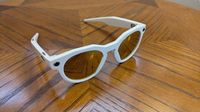Meta is no stranger to bold bets on the future of technology, but this week, the company is poised to take another leap with the highly anticipated unveiling of its Hypernova smart glasses. Set to be showcased at the Meta Connect event on Wednesday, September 17, 2025, the new device has been at the center of swirling rumors, accidental leaks, and growing excitement among tech enthusiasts and industry watchers alike. According to Mashable, the Hypernova glasses could mark a pivotal moment for Meta, as they are expected to be the company’s first smart eyewear featuring a built-in display—a move that would place Meta in direct competition with emerging players like Xreal and challenge the status quo in wearable tech.
So, what makes the Meta Hypernova smart glasses so special? For starters, their most headline-grabbing feature is the inclusion of a heads-up display (HUD) embedded in the right lens. This innovation takes Meta’s wearable ambitions far beyond previous collaborations, such as the Ray-Ban smart glasses, which offered camera functionality but stopped short of integrating a full display. As PCMag reports, the HUD will allow users to interact with Meta AI, navigate maps, and even translate signs in real time. Importantly, the display is designed so that only the wearer can see it—no one standing in front of you will be able to catch a glimpse of your digital world.
The excitement around the Hypernova glasses isn’t just about what you see, but also how you control it. Alongside the eyewear, Meta is set to introduce a wristband accessory that leverages cutting-edge surface electromyography (sEMG) technology. This wristband reads the electrical signals generated by wrist and finger movements, translating them into digital actions with surprising precision. In a leaked promotional video, which briefly appeared on Meta’s own YouTube channel before being taken down (as first reported by UploadVR and covered by The Shortcut), a user can be seen moving a finger across a surface to type and send a message—no need to touch the glasses or speak out loud. This kind of hands-free, intuitive control could become the new standard for wearable interfaces, making the glasses not only futuristic but genuinely practical for everyday use.
Price is always a sticking point with new tech, but Meta appears to be taking a measured approach. According to reporting from earlier this summer cited by Mashable and PCMag, the Hypernova smart glasses are expected to retail for around $800. That’s a significant drop from the originally planned price of over $1,000, a move attributed to Meta’s desire to spur demand and avoid the fate of devices like the $3,500 Apple Vision Pro, which struggled to gain traction. By keeping the price under $1,000, Meta is signaling its intent to reach a broader audience, even if it means sacrificing some profit in the short term.
Of course, with advanced features come some trade-offs. The new Ray-Ban Display glasses (as they’re also being called in some leaks) are expected to be slightly bulkier and heavier than their predecessors. The Shortcut notes that the new model will weigh about 70 grams, compared to the 50 grams of the current Ray-Ban smart glasses. This increase is largely due to the added computing hardware required to power the display and AI capabilities. Whether the extra weight will be noticeable or bothersome remains to be seen, but Meta is clearly betting that the convenience and wow-factor of the built-in HUD will outweigh any minor discomfort.
Functionality is at the heart of Meta’s pitch. The built-in display is rumored to support a range of tasks, from snapping photos and videos to following turn-by-turn map directions and interacting with Meta’s suite of apps—Facebook, WhatsApp, and Instagram. AI integration is expected to play a big role, with the display enabling users to access Meta AI for information, assistance, and possibly even real-time translation of signs and messages. This could be a game-changer for travelers, commuters, and anyone who wants information at a glance without pulling out a phone.
The wristband’s sEMG technology, teased by Meta as far back as 2022, is a standout feature in its own right. By sensing the subtle electrical activity in the wearer’s wrist muscles, the wristband can interpret finger and hand movements with remarkable accuracy. This means users can control the glasses’ interface—switching apps, typing messages, or navigating menus—simply by moving their fingers, all without any physical buttons or awkward gestures. It’s a glimpse into a future where technology responds to us as naturally as we move.
Meta’s ambitions don’t stop with the Hypernova glasses. The company is also expected to reveal new Oakley Meta Sphaera glasses at the Connect event. These glasses, designed around Oakley’s Sphaera lineup, feature a camera at the center of the frame but do not include a built-in display. Instead, they seem to be aimed at high-performance athletes who want eye protection and hands-free camera access. The Oakley Meta HSTN glasses, which recently launched at $400, offer another example of Meta’s expanding portfolio in the smart eyewear space, coming in a variety of frame and lens color combinations.
Anticipation is running high for Meta CEO Mark Zuckerberg’s keynote at the Connect event, scheduled for 5pm PT / 8pm ET on September 17, 2025. The company’s accidental video leaks and the steady drip of rumors have only fueled curiosity about what surprises may be in store. As PCMag points out, the Hypernova glasses’ launch under the Ray-Ban brand is a strategic move, leveraging the iconic eyewear label’s style and credibility to help smart glasses go mainstream.
For now, the exact release date of the Meta Hypernova glasses remains under wraps. While it’s reasonable to expect a launch before the end of 2025—especially if Meta is ready to show off the product in detail this week—consumers will have to wait for an official announcement to know when they can get their hands (and wrists) on the new device.
As the lines between the digital and physical worlds continue to blur, Meta’s Hypernova smart glasses may well represent the next big step in wearable computing. With their built-in display, advanced AI integration, and innovative wristband control, they promise to make the future of augmented reality just a little more tangible—and a lot more wearable.




